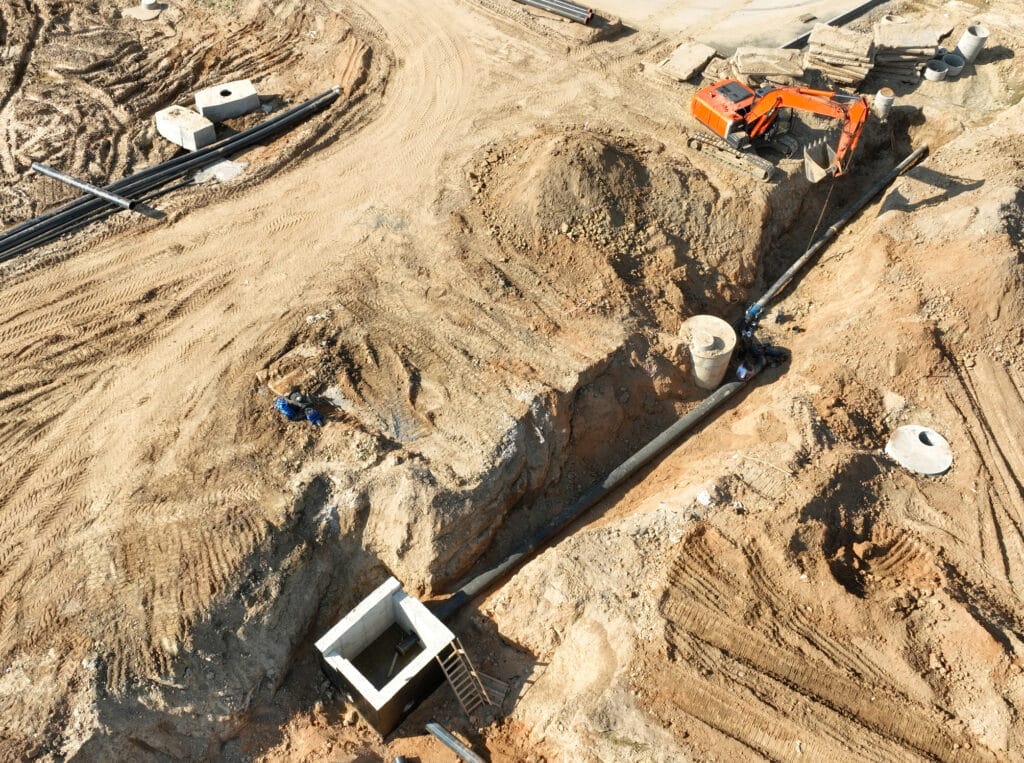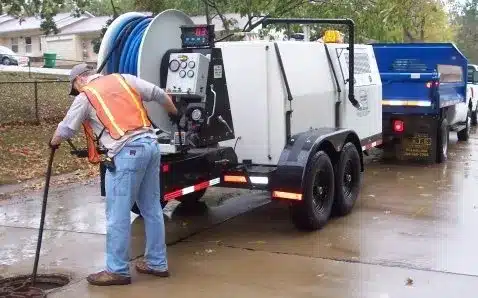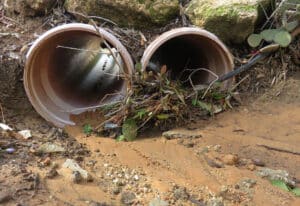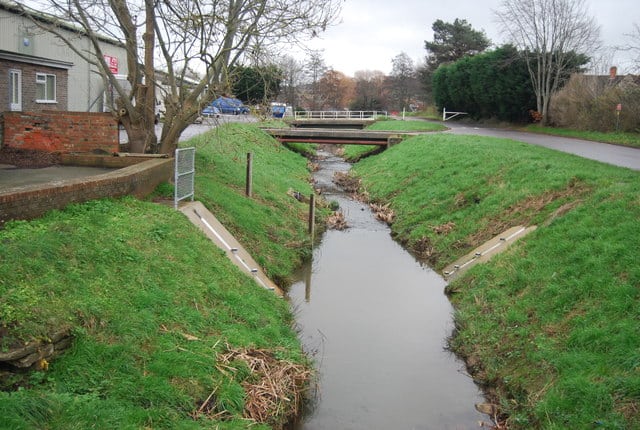 A drainage easement can help save you and your neighbors from that nightmare.
A drainage easement can help save you and your neighbors from that nightmare.
A drainage easement is a legal agreement to grant government authorities limited access to maintain drainage infrastructure on your property.
There are strict guidelines about building anything near this drainage infrastructure that must be followed.
Drainage easements can be a mixed bag for property owners. On one hand, they’ll help keep your property safe from flooding. And on the other hand, they can cut down your property value.
So don’t sign any drainage easement documents without consulting an experienced eminent domain lawyer first. They can permanently impact your ownership rights and land value.
Your lawyer will ensure you’re fully compensated for any damages you face caused by the drainage easement.
Let's Go Beyond, to Bring You Back
Let's get you the compensation you're entitled to. Get a FREE Consultation today.
Let's Go Beyond, to Bring You Back
You deserve the compensation you’re entitled to, call for your FREE Case Review today.
Understanding Drainage Easements
A drainage easement is a right you give to a government authority to access and use a specific part of your property for water management.
The keywords here are ‘access’ and ‘use.’
It means your property rights are at stake. You’re limiting your own freedom to use a specific part of your property by signing this agreement.
A drainage easement can be used for two main reasons:
- Directing the flow of storm water and ensuring its path is free from all obstructions
- Drainage infrastructure maintenance
It’s important to know that signing this agreement will have permanent consequences. You need to sign the drainage easement and record it at your local area’s register of deeds.
Once you’ve done that, you’ve officially appended your property deed. This agreement will remain tied to your property deed and will be transferred to any future owners. You’ll still own the land and pay taxes on it. You’re only giving specific rights to government authorities.
It can only be taken away if the government violates the agreement or willingly surrenders the easement.
An easement area can include:
- Ditches
- Creeks
- Storm drains
- Ponds
- Culverts
- Slope drains
- Pipes
- Channels
Enforceability and Legal Requirements
There are three essential parts in the legal process of establishing a drainage easement:
- Signing and registering the drainage easement – You can create a drainage easement by setting up a transfer in a deed, a will, or a contract. Both parties need to put down the terms of access and use in writing first. They will have to sign it, get a notary seal, and record it with the local county’s register of deeds.
- Enforceable rights – Both the property owner and the government authority must follow the responsibilities that they agreed upon. They must avoid putting unnecessary stress and burden on each other. You have the right to seek compensation from the easement holder if they’ve violated the terms of the agreement. The court may even terminate the easement in certain cases. However, they’re entitled to legal remedies too if you’ve obstructed them from carrying out their duties.
- Transferability – Easements are usually independent of ownership status. They will be transferred to the new property owner, who will have to comply with the agreement terms. It’s important to look up if there are any easements tied to the property you’re about to buy.
Texas Eminent Domain Lawyer
Get Compensated For Your Injuries & Damages! Call Us For A FREE Case Review And Know What Your Case Is Worth.
Restrictions and Limitations

It includes a huge set of property restrictions, such as:
- No structures with a deep foundation
- No construction that obstructs or diverts the drainage
- No fencing or limited types of fencing, depending on the nature of the easement
- No sheds or walls
- No landscaping
- No pools, courts, or playhouses
That’s a lot of NOs to keep up with. Even if you never planned to modify your property, it’s still going to eat into your property value.
Lack of utility = lack of value.
You won’t get the price you deserve if you plan to sell or mortgage the property someday.
You’ll still have to bear the responsibility to maintain the drainage area and provide easy access to government authorities. You’ll have to take measures to prevent land erosion from obstructing the drainage.
Government authorities are also permitted to make reasonable modifications to maintain the drainage area. Any damages suffered in this process will drag down your property value further.
It’s hard to convince insurance companies to provide coverage to a property with drainage issues. This will further sabotage your ability to secure a mortgage.
Why? Because homeowner’s insurance is a prerequisite for securing it. You may have to purchase additional flood hazard insurance to secure your property.
So make sure you thoroughly review the restrictions you’ll have to follow before signing a drainage easement.
Maintenance Responsibilities
It’s the government’s duty to ensure drainage easement areas are properly maintained. However, they’ll direct most of the maintenance responsibilities to the property owner.
The easement holder will take charge of any construction and repair work needed in the area. They will take charge of more heavy-duty maintenance work like replacing broken pipes, repairing sinkholes, clearing drain pipes, and catch basins.
Your primary responsibility is to keep the drainage area free from obstructions.

- Regular mowing and weed removal around the easement area. For instance, wild grass can cover up the entry to a storm drain and prevent drainage.
- Removal of soil and rocks that can get caught in the drainage channels
- Leveling the soil near the easement area to prevent soil erosion that can obstruct drainage channels
- Maintaining detention basins to stop water retention during dry periods
- Filling erosion gullies and reseeding the area to promote native vegetation growth
There are clear guidelines for controlling excess vegetation in the easement area. Vegetation shouldn’t be over 18 inches in height to allow easy drainage.
Consulting an Eminent Domain Attorney
There are two scenarios where you may need to consult an eminent domain attorney:
- Reviewing and negotiating the drainage easement before you sign it
- Filing a claim against the government authority for violating the agreement and seeking compensation
Hire an experienced eminent domain lawyer in the beginning, and you may never even end up facing the second scenario. They’ll evaluate all the risks you’re taking on and ensure you get comfortably compensated for any loss of property value.
Your lawyer will try to limit the land restrictions and maintenance work needed from your end. This will protect your property value and save you the stress of extensive maintenance tasks.
The best part is you won’t have to pay our experienced domain lawyers anything up front.
You only have to pay us once we win your settlement. And we guarantee to get you a much better offer than the one you first received from the government.
| Drainage Easement on Property? Know Your Rights Texas Eminent Domain | |
|---|---|
| What a Drainage Easement Is | A legal right you grant (usually to a government authority) to access and use a defined part of your land for water management (stormwater flow and infrastructure maintenance). It attaches to the deed and transfers to future owners. |
| Where It Can Apply | Areas like ditches, creeks, storm drains, ponds, culverts, slope drains, pipes, and channels. |
| Legal Requirements & Enforceability |
|
| Common Restrictions (Impact on Value) | Often no deep foundations, no structures that obstruct/divert drainage, limited/ no fencing, no sheds/walls, no landscaping, and no pools/courts/playhouses—reducing utility and market value. Insurance and mortgage approval can be harder; flood coverage may be required. |
| Maintenance – Who Does What? | Government typically handles heavy repairs (e.g., replacing pipes, fixing sinkholes, clearing catch basins). Owners must keep areas free of obstructions:
|
| When to Call an Attorney |
No upfront fees; fees are due if the firm wins a settlement. |
| Determining Fair Compensation | Guided by the Fifth Amendment “Takings” clause. Key factors:
|
| Quick FAQ |
|
| Talk to Wyly & Cook | Get a FREE Case Review on drainage easements and compensation. |
Determining Fair Compensation
The Takings Clause in the Fifth Amendment prevents government authorities from taking control of any private property until the owner receives just compensation.
Your eminent domain lawyer will evaluate these four key elements to determine the right compensation for you:
- Any decrease in the market value of your land because of the imposed restrictions
- Any damages and loss of amenities suffered by the property owner
- Expenses for maintaining the drainage easement area
- Relocation expenses
Your compensation sum mainly depends on the size of the government’s takings of your land. They will give you an offer proportionate to their land control and access demands.
Texas Eminent Domain Lawyer
Get Compensated For Your Injuries & Damages! Call Us For A FREE Case Review And Know What Your Case Is Worth.
Frequently Asked Questions
What is the impact of a drainage easement on property value?
Here’s how a drainage easement can affect your property value:
- Decreased market value – You have to disclose any easements tied to your property when you try to sell it. The limited land utility and stress of maintenance may turn them away from the deal.
- Loan struggles – Any decrease in property valuation will be a thorn in your side for taking loans and mortgages. Your drainage easement property restrictions and risk of flooding may be viewed as a liability.
- Insurance challenges – The risk of property flooding may lead to companies denying you homeowner insurance or charging higher premiums for getting it. You may have to pay for additional flood hazard insurance.
- Tax implications – As long as you’re still the primary land owner, you have to pay taxes on it. Your lawyer can negotiate with the government to grant you more favorable tax responsibilities. You won’t get any special tax benefit from selling a property with a drainage easement.
Can I build structures on a property with a drainage easement?
It depends on whether your construction limits access to the easement area or messes with the drainage infrastructure.
As long as it doesn’t interfere with this, you have the freedom to build the structure you need. It’s best to consult your eminent domain lawyer to clear the path for your plans when you sign the agreement.
Who is responsible for maintaining a drainage easement?
Responsibilities for drainage easement are shared between the property owner and easement holder. The government authority will generally take care of the heavy-duty repair and maintenance work.
For instance, repairing pipes and clearing catch basins requires special equipment and expert supervision. So, property owners don’t have to worry about taking care of it.
However, the majority of maintenance work will be taken care of by the property owner, including tasks such as:
- Controlling excess vegetation near the easement area to prevent clogging of drainage channels.
- Getting rid of excess soil and rocks obstructing drainage channels
- Taking proactive measures to prevent soil erosion L
- Taking care of detention basins to prevent water accumulation during dry seasons
- Fixing erosion gullies and reseeding the easement area
Are there any insurance requirements for properties with drainage easements?
Insurance companies will give you a tough time if your property has a drainage easement area. A high-risk property means low profit for your insurer.
There are greater chances of you demanding a payout because of a flooding issue.
So chances are they will either deny you homeowner’s insurance. Or they may charge you massive premiums to stay covered. o provide coverage to a property with drainage issues.
It’s recommended to buy additional flood hazard coverage to get properly compensated for any possible damages.
How can an eminent domain attorney assist with a drainage easement case?
Here’s why you need an experienced eminent domain lawyer to back you up:
- Your lawyer will review the government’s claim and ensure no property rights are being infringed
- They’ll hire a network of expert appraisers, surveyors, and environmentalists to present a strong and legitimate counter offer
- They’ll ensure any unnecessary construction restrictions and maintenance obligations are scrapped from your agreement
- Negotiate a settlement that’s much higher than the government’s initial offer
- Take charge of all legal correspondence and actions to free you from all stress
- File a lawsuit to get you compensated in case the government violates the agreement in any way
How is fair compensation determined for a drainage easement?
Fair compensation is about much more than getting the market value for a patch of land.
There are a number of factors you must carefully evaluate to determine fair compensation for a drainage easement:
- Loss of market value due to property restrictions
- Loss of income
- Lack of access
- Losing amenities and not being able to fully enjoy the property
- Damages caused by construction and maintenance work done by the government authority
- Maintenance costs
- Relocation expenses


